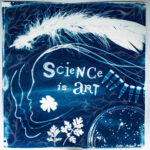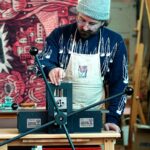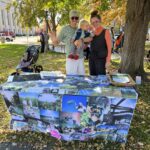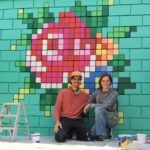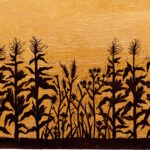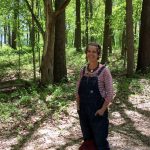Augusta, Mich. — An upcoming workshop, hosted at the W.K. Kellogg Bird Sanctuary, will blend art and science into a beautiful sun print piece. Callie Chappell, an artist, science communicator, scientist, and a 2023 artist-in-residence with the KBS Long-term Ecological Research program, will lead the workshop, set for 11 a.m. to 1 p.m. Saturday, July 29, at the Sanctuary. Participants will be encouraged to bring culturally or personally significant materials with them for use in the project. The workshop will begin with a short walk through the
2023 KBS LTER Artist-in-Residence set for June 12-18
A Kalamazoo woodcut printmaker and teacher is the 2023 Artist-in-Residence for Michigan State University’s W.K. Kellogg Biological Station in Hickory Corners, Michigan. Launched by MSU in Summer 2022 in an effort to promote art and science collaborations, the Farmscapes to Forests: Kellogg Biological Station (KBS) Long-Term Ecological Research (LTER) Artist-in-Residence Program is now in its second year and will host Trevor Grabill from Flat Mountain Press June 12-18 as the 2023 Artist-in-Residence. According to Gretel Van Wieren, Professor of Religious
DreamScene Placemaking: Artists-in-Residence 2022
Anna Lee Roeder and Erik Vasilauskas are the husband and wife team behind DreamScene Placemaking in Kalamazoo, and our 2022 KBS LTER Artists in Residence. They visited KBS twice during their Residency in 2022. For their first visit in the spring, they stayed with us for a week and toured KBS, visited our long-term experiments, and met with scientists, students, and staff. In the fall, they presented a brownbag seminar on the development of their artistic styles and how the residency fit into that trajectory. As a product of their residency, Anna and Erik engaged the KBS summer
New KBS LTER Artist-in-Residence program aims to create intersection between art and research
This spring, Michigan State University launches the Farmscapes to Forests: Kellogg Biological Station (KBS) Long-Term Ecological Research (LTER) Artist-in-Residence Program, which will welcome artists from across all mediums to spend a week at the Kellogg Biological Station in Hickory Corners, Michigan, followed by a culminating visit in the fall or winter to share their work. Supported by the National Science Foundation, Gretel Van Wieren, Professor in MSU’s Department of Religious Studies, is leading the program in its first collaboration with Dream Scene Placemaking,
Prairie strip ecology, art, and advocacy in the LTER: Reflections from an LTER Fellow
Corinn Rutkoski is a graduate student in Sarah Evan's lab at the Kellogg Biological Station. She is broadly interested in the use of perennials in agricultural systems, science policy, and soil health. Her research path has been propelled by a reciprocal inspiration among ecology, conservation, and creativity. In September 2018, Lisa Schulte Moore was scheduled to give a seminar at KBS titled Prairie strips improve biodiversity and multiple ecosystem services from corn-soybean croplands. At the time, I was a technician in Sarah Evans’ lab at KBS, considering graduate school
Join the Kellogg Biological Station community for a celebration of art and science
Richland, MI – What happens when one combines science and art? Scientists and other members of the W.K. Kellogg Biological Station community have spent the past several months exploring this question, and are gathering next month to showcase and celebrate the results of that exploration. The public is invited to the free event, called the Allurement Salon, from 6:30 to 8:30 p.m. Thursday, Nov. 7, in the Richland Community Hall, located at 8985 Gull Road, across from the Richland Harding’s Market. The salon will feature expressions of research and the natural world through original
On Data and Reverie: A Farmer and Writer-in-Residence at the KBS LTER
A blooming redbud tree flashed a profusion of pink outside the large windows in the W.K. Kellogg Biological Station’s Terrace Room. Inside, vases of freshly-picked plants spiffed up the small tables set around the room: milkweed, wood sorrel, garlic mustard, purple dead nettle, dame’s rocket, and motherwort. The bouquets were more than decoration; they were little collections of inspiration from a week spent exploring the lands, people and research at the W.K. Kellogg Biological Station. Self-described “people, plants and dirt-lover” Erin Schneider assembled the bouquets ahead of a workshop
